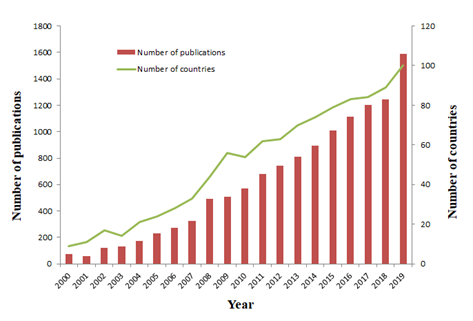According to the World Health Organization (WHO), Intimate Partner Violence (IPV) includes “any behavior by an intimate partner or ex-partner that causes physical, sexual or psychological harm, including acts of physical aggression, sexual coercion, psychological abuse and controlling behaviors”.
- intimate partner violence
- HIV
- bibilometric
- keywords analysis
1. Introduction
As Intimate Partner Violence (IPV) is a worldwide public health problem, more and more scholars have been participating in the study of IPV and how to prevent the violence. A bibliometric analysis is performed to evaluate the publications in the Intimate Partner Violence (IPV) field from 2000 to 2019 based on the Science Citation Index Expanded (SCI-E) and the Social Sciences Citation Index (SSCI) databases. The results showed that the USA takes the leading position in this research field, followed by Canada and the UK. The University of North Carolina has the most publications and Harvard University won the first place in terms of h-index. The London School of Hygiene and Tropical Medicine led the list of average citations per paper. The Journal of Interpersonal Violence, Journal of Family Violence and Violence Against Women are the top three most productive journals in this field, and Psychology is the most frequently used subject category. Keywords analysis indicated that, in recent years, most research focuses on the research fields of “child abuse”, “pregnancy”, “HIV”, “dating violence”, “gender-based violence” and “adolescents”.
2. IPV is a World Health Issue
According to a WHO report “Prevalence and health effects of intimate partner violence and non-partner sexual violence” in 2013[1], over one in three women worldwide have experienced physical and/or sexual partner violence, or sexual violence by a non-partner. IPV levels vary in different regions due to a variety of cultural, economic level, social system, and religious reasons, with the highest prevalence in Africa, the Eastern Mediterranean and the South–East Asia Regions, followed by the Americas. High-income regions, the European and the Western Pacific Regions have a relatively low prevalence. Since IPV is associated with many serious physical and mental health consequences: physical injury[2][3][4], post-traumatic stress disorder[5][6][7], HIV infections[2][8][9][10][11][12], induced abortion[13][14][15], alcohol use disorders[16][17][18][19][20][21], adolescent pregnancy[22][23][24], dating violence[25][26][27][28], and more, scholars from many countries have been participating in the study of IPV and how to prevent the violence. The WHO, with other agencies, launched a RESPECT[29] women program to prevent violence against women in 2019.
This review presented a general overview of the Intimate Partner Violence (IPV) research area in terms of leading countries, institutes, and research trends. The USA definitely led IPV research with the most publications and highest h-index. There was no doubt that more and more countries have been participating in IPV research. Since IPV is a world health issue, we expect that, as more and more researchers join this research area, more results will be published based on the collaboration between different research groups all over the world, which will continue to make an effort to stop or prevent IPV. Needless to say, how to prevent IPV more effectively is still a big challenge, although many scholars have made various suggestions to intervene or stop IPV. Furthermore, more and more researchers have recognized that IPV is associated with women's vulnerability to HIV to some extent.
This study can help potential researchers to quickly understand IPV globally. It also can provide useful information for relevant research in terms of identifying the research trends and potential collaborators. Additionally, this study can help policy makers improve policymaking to prevent IPV

